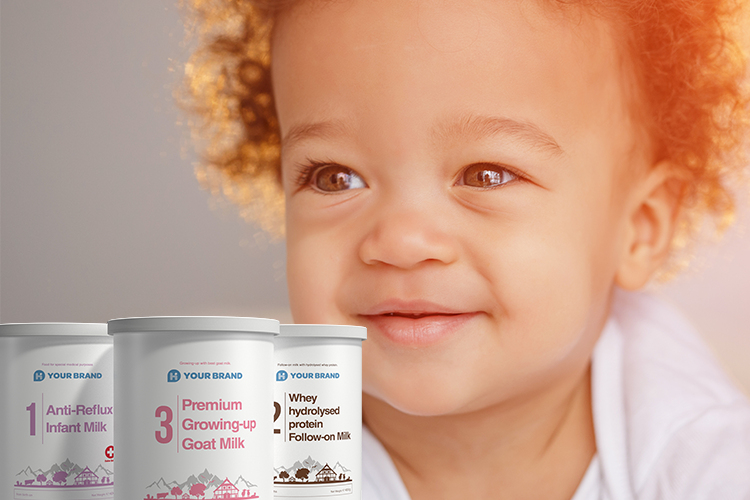
In the previous issue of HOCHDORF Inside, published in Autumn 2016, we followed babies Emma and Noah through their first months of life. We saw how important it was for the development of Emma and Noah to establish healthy microbiota.
But what does healthy microbiota or gut flora look like? It comprises numerous harmless strains of bacteria like Lactobacilli and Bifidobacteria. These good bacteria protect us, from foreign intruders and pathogens for example, and produce important digestive enzymes and vitamins. Researchers have discovered that nutrition plays an important role (1) in the number of individual strains of bacteria that are established in our gut. Bacteria also need energy in the form of food. But not all types of bacteria like the same food. Healthy bacteria, for instance, prefer specific carbohydrates such as galactooligosaccharides (GOS), oligofructose and inulin, which are all types of prebiotics.
"Between the age of six and 18 months, the microbiota alter quite dramatically as a result of the change in diet."
The first months went perfectly for Emma and Noah. Emma was breast fed and Noah was fed with an infant formula enriched with GOS, containing prebiotics and all the important nutrients required for life. Now they are both exploring the world with curiosity and ready for the next big step: the weaning phase and the move to their first solid foods. Both babies need lots of energy to grow. Before they reach the age of one their birth weight will triple and their size will double; their brains will also grow disproportionately in the first three years. Breast milk or infant formula are no longer enough on their own. For healthy physical and mental development, Emma and Noah need semi-solid food with additional nutrients including protein, iron and zinc, plus unsaturated healthy fatty acids such as DHA for healthy brain development (see HOCHDORF Inside, Issue 4, Winter/Spring 2016).
Introducing semi-solid food affects the microbiota
Various scientific studies have shown that the composition of intestinal microbiota changes significantly when a child is between six and 18 months old, depending on their diet. New foods are arriving on the menu every month for Noah and Emma and these can have a positive or a negative effect on the composition of the microbiota. It is only once they reach the age of three that the microbiota (2) of both babies will stabilise and become similar to that of an adult. The phase of moving to semi-solid foods can therefore have a life-long impact on the microbiota and the health of Emma and Noah.
It’s worth starting early
Noah’s parents were aware of the impact that nutrition would have on the health of their son both now and in the future. Noah is now receives a follow-on formula instead of infant formula. It contains more nutrients such as iron, zinc and the same prebiotics as his infant formula. His parents should avoid cow’s milk initially. Standard cow’s milk is not particularly suitable for young children; it contains too little iron, for example. Alongside the follow-on formula, Noah is also being introduced to a new fruit, vegetable or cereal porridge every other day to ensure he receives sufficient fibre. This step-by-step approach allows his parents to check how Noah’s metabolism reacts to new foods. He is given unsweetened herbal teas and water to drink as Noah’s parents are keen to make sure he does not have any unnecessary sugar, fat or salt.
It’s worth starting early – the sooner Noah becomes accustomed to foods low in salt, sugar and saturated fat with natural flavours, the less likely he will be to reject unprocessed foods in the future. Children prefer the primary foods that are presented to them most often (3) so parents should persevere in offering those that are less popular. Children then have the chance to shake off their reluctance to try certain foods before it becomes too entrenched. Thanks to his parents’ approach Noah is already very healthy, which also strengthens his immune system.
Emma has also developed into a healthy and lively little girl. To the delight of her parents, Emma is a good eater, although she knows exactly what she wants. It has to be sweet and colourful. She doesn’t like plain porridge or unsweetened fruit purées or drinks without sugar at all. Emma’s mum and dad tried a few times to give her plain foods but quickly abandoned the attempt in the face of their daughter’s commotion. Emma became accustomed to the pleasant taste of sugar very quickly. Her parents couldn’t believe that their daughter was consuming lots of sugar and additives in her solid foods and colourful children’s snacks. And they found it really convenient to quickly pack a sweet apple puree or a colourful pot of children’s jelly to take with them when they were out or in the car on the way to nursery. Of course, these are not a problem if you also include healthy meals and snacks.
Dysbiosis – imbalance in bacteria
Emma’s microbiota were not very happy on account of the highly sugared fruit juice and children’s snacks. Emma may have been consuming too many calories, but they didn’t provide the food the healthy microbiota required. There wasn’t enough dietary fibre and healthy carbohydrate. Because not all sugar is the same. Whole grain products, fruits and potatoes contain healthy oligosaccharides and polysaccharides which are good for the gut. The density of the healthy bacterial colonies on Emma’s intestinal mucosa decreased. In other words, the good bacteria could barely inhibit the growth of the pathogenic bacteria (4). The result was a disturbed microbial colony, or dysbiosis. There was an imbalance in Emma’s microbiota and it began to cause her more harm than good. Emma’s immune system began to weaken and she often suffered from infections, a possible side effect of dysbiosis (5).
The fact that the gut and brain are closely connected with each other and interact through the gut brain axis should not be underestimated.
Dysbiosis is not something to be underestimated. The gut reduces its enzyme activity and the body can absorb fewer vitamins, carbohydrates, amino acids and minerals. In the worst cases it can lead to malnutrition. According to some studies, dysbiosis can cause chronic obesity and related secondary diseases such as diabetes and cardiovascular disease. A weakened immune system also leads to increased inflammations and to atopic diseases such as neurodermatitis or asthma (7). The fact that the gut and brain are closely connected with each other and interact through the “gut brain axis” should not be underestimated. Dysbiosis can affect the mind and lead to depression and autism in certain circumstances (8, 9).
Emma was lucky. Following the first signs of neurodermatitis and an analysis of her eating habits the paediatrician prescribed a change in diet. Emma’s parents have consciously fed their daughter the recommended amount of healthy carbohydrates and fibre since then. They watch that Emma doesn’t have too much fat and that any fat comes from healthy unsaturated fatty acids such as DHA.
Infant formula and Kids’ Food from HOCHDORF – healthy and convenient
Since the change in diet, Emma has been in much better health. Despite the adjustment, her parents have not had to spend extra hours cooking. There are now products on the market that offer convenience. At HOCHDORF, for example, we offer ingredients for weaning foods based on milk powders that also contain additional cereals, vegetables and fruits, depending on the variety. The products just need to be mixed with warm water to produce a healthy baby porridge without any additional sugar or salt. Our range includes healthy snack products for older children, such as our wellness crisps, as well as specialist children’s snacks made from whole grain, maize and carrots. Our dried vegetable and fruit crisps are convenient and healthy for on the move. Our Marbacher Ölmühle division also offers healthy ingredients for children. Our organic rapeseed oil for instance is perfect for mixing into children’s porridge.
Healthy nutrition for small children doesn’t stop at home; it is possible anywhere. At HOCHDORF we offer solutions that meet today’s nutritional trends and lifestyle – healthy nutrition wherever and whenever we want.
Further information
- Short article "Health benefits of prebiotics"
- Overview "Dysbiosis"
- Article "Carbohydrates – It's all the mix"
- Article "Prebiotics in infant formula, part 1"
- Article "Functional gastrointestinal disorders"
Sources
1) Arumugam M, Raes J et al. Enterotypes of the human gut microbiome, published in Nature. 2011 May 12; 473(7346): 174–180.
2) Yatsunenko T, Rey FE et al. Human gut microbiome viewed across age and geography. Nature, 486 (2012), pp. 222–227.
3) SGE Schweizerische Gesellschaft für Ernährung: Hintergründe zur Ernährungsscheibe.
4) Frick J-St, Autenrieth IB. Wechselwirkung zwischen Darmflora und intestinalem Immunsystem, in: Probiotika, Präbiotika und Synbiotika, hg von Stephan C Bischoff, Thieme Verlag, Stuttgart 2009.
5) Oriá RB, Murray-Kolb LE et al. Early-life enteric infections: Relation between chronic systemic inflammation and poor cognition in children. Nutrition Reviews, 74(6), 374–386. DOI: 10.1093/nutrit/nuw008, published 2016.
6) Graham C, Mullen A et al. Obesity and the gastrointestinal microbiota: a review of associations and mechanism. Nutr Rev (2015) 73 (6): 376–385. 2015. Published by Oxford University Press on behalf of the International Life Sciences Institute.
7) Haahtela T et al.: The biodiversity hypothesis and allergic disease: world allergy organisation position statement. World Allergy Organ J. 2013 Jan 31;6(1):3.
8) Borre YE et al.: Microbiota and neurodevelopmental windows: implications for brain disorders. Trends Mol Med. 2014 Sep; 20(9):509–18.
9) Grenham et al.: Brain-gut-microbe communication in health and disease. Front Physiol. 2011 Dec 7;2:94.










Leave a comment